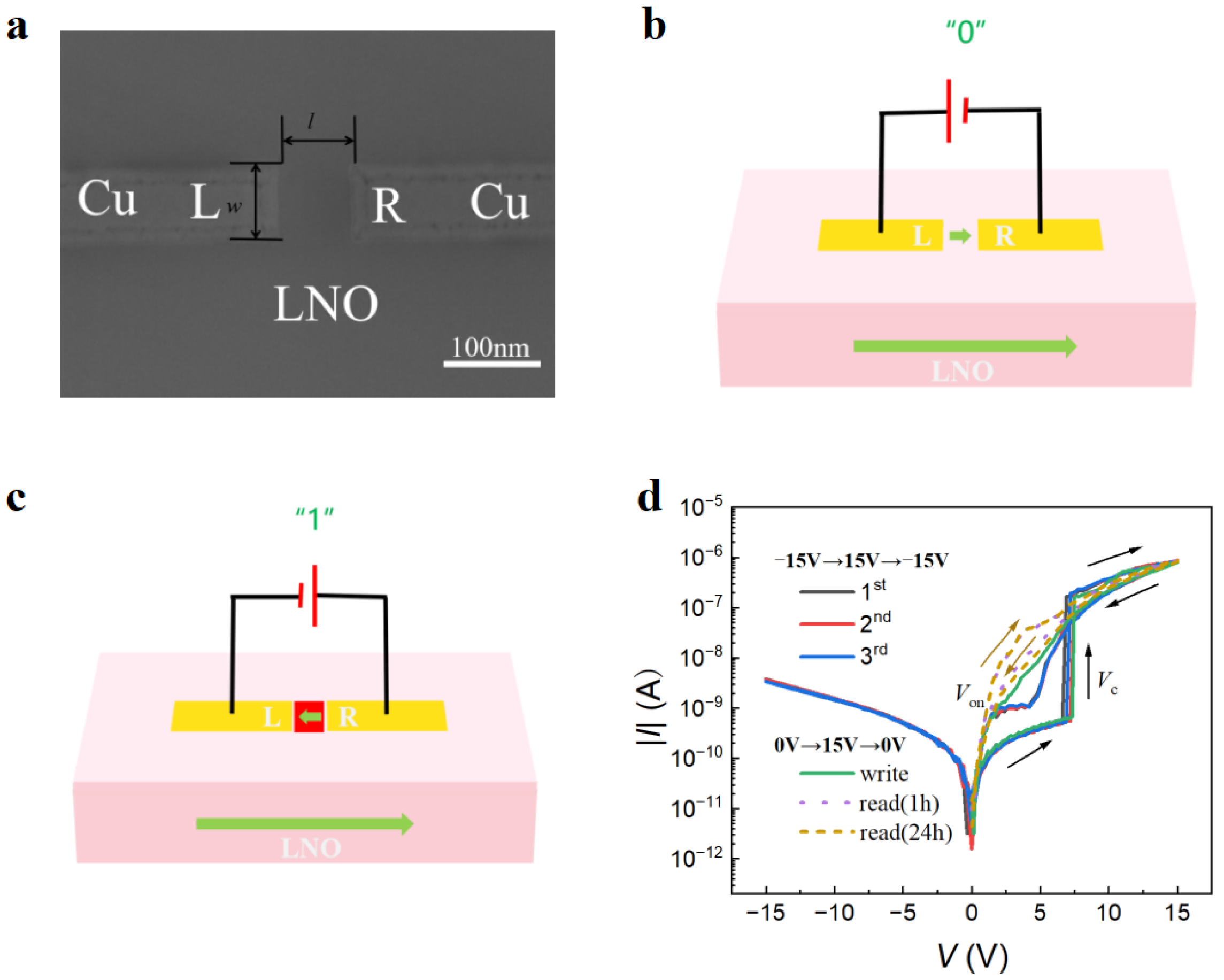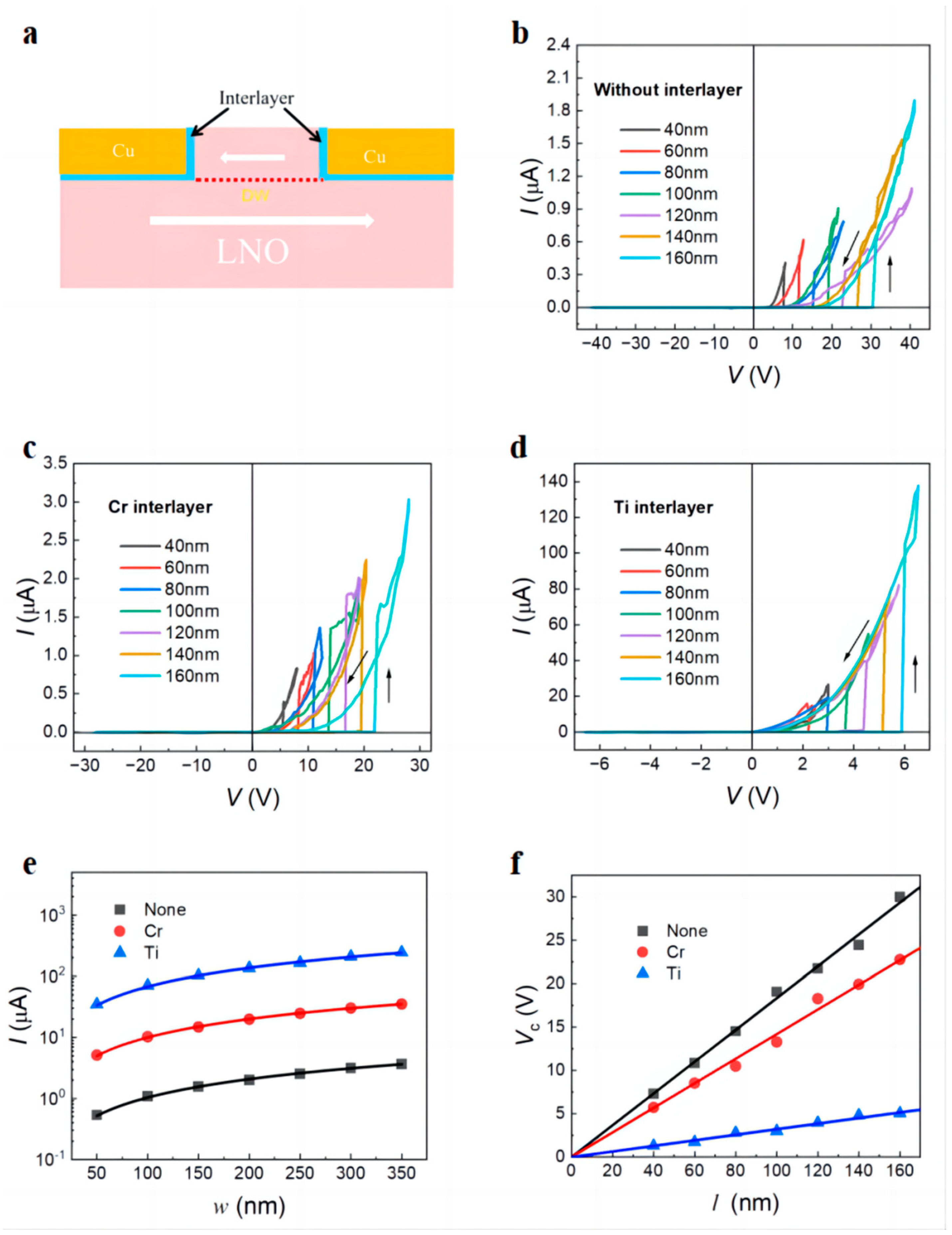High-Performance LiNbO3 Domain Wall Memory Devices with Enhanced Selectivity via Optimized Metal–Semiconductor Contact
Abstract
:1. Introduction
2. Experimental Methods
3. Results and Discussion
4. Conclusions
Author Contributions
Funding
Data Availability Statement
Conflicts of Interest
References
- Li, Z.; Meng, J.; Yu, J.; Liu, Y.; Wang, T.; Xu, K.; Zhu, H.; Sun, Q.; Zhang, D.W.; Chen, L. Stabilizing the Ferroelectric Phase in HfAlO Ferroelectric Tunnel Junction with Different Bottom Electrodes. IEEE Electron. Device Lett. 2023, 6, 947–950. [Google Scholar] [CrossRef]
- Liu, C.; Yang, Q.; Zeng, B.; Jiang, Y.; Zheng, S.; Liao, J.; Dai, S.; Zhong, X.; Zhou, Y.; Liao, M. Orientation independent growth of uniform ferroelectric Hf0.5Zr0.5O2 thin films on silicon for high-density 3D memory applications. Adv. Fun. Mater. 2022, 49, 2209604. [Google Scholar] [CrossRef]
- Wang, T.Y.; Meng, J.L.; Rao, M.Y.; He, Z.Y.; Chen, L.; Zhu, H.; Sun, Q.; Ding, S.J.; Bao, W.Z.; Zhou, P.; et al. Three-dimensional nanoscale flexible memristor networks with ultralow power for information transmission and processing application. Nano Lett. 2022, 6, 4111–4120. [Google Scholar] [CrossRef]
- Meng, J.L.; Wang, T.Y.; He, Z.Y.; Chen, L.; Zhu, H.; Ji, L.; Sun, Q.; Ding, S.J.; Bao, W.Z.; Zhou, P.; et al. Flexible boron nitride-based memristor for in situ digital and analogue neuromorphic computing applications. Mater. Horiz. 2021, 2, 538–546. [Google Scholar] [CrossRef]
- Wang, T.; Meng, J.; Zhou, X.; Liu, Y.; He, Z.; Han, Q.; Li, Q.; Yu, J.; Li, Z.; Liu, Y.; et al. Reconfigurable neuromorphic memristor network for ultralow-power smart textile electronics. Nat. Commun. 2022, 1, 7432. [Google Scholar] [CrossRef]
- Xia, F.; Jiang, D.J.; Xiong, J.; Sun, N.H. A Survey of Phase Change Memory Systems. J. Comput. Sci. Technol. 2015, 30, 121–144. [Google Scholar] [CrossRef]
- Dong, X.; Jouppi, N.P.; Xie, Y. PCRAMsim: System-Level Performance, Energy, and Area Modeling for Phase-Change RAM. In Proceedings of the IEEE/ACM International Conference on Computer-Aided Design, ICCAD, San Jose, CA, USA, 2–5 November 2009. [Google Scholar]
- Chen, Y.Y.; Goux, L.; Clima, S.; Govoreanu, B.; Degraeve, R.; Kar, G.S.; Fantini, A.; Groeseneken, G.; Wouters, D.J.; Jurczak, M. Endurance/Retention Trade-Off on HfO2/Metal Cap 1T1R Bipolar RRAM. IEEE Trans. Electron Dev. 2013, 60, 1114–1121. [Google Scholar] [CrossRef]
- Boukhobza, J.; Rubini, S.; Chen, R.; Shao, Z. Emerging NVM: A Survey on Architectural Integration and Research Challenges. ACM Trans. Design Autom. Electr. Syst. 2018, 23, 14. [Google Scholar] [CrossRef]
- Khan, A.I.; Keshavarzi, A.; Datta, S. The Future of Ferroelectric Field-Effect Transistor Technology. Nat. Electron. 2020, 3, 588–597. [Google Scholar] [CrossRef]
- Endoh, T.; Koike, H.; Ikeda, S.; Hanyu, T.; Ohno, H. An Overview of Nonvolatile Emerging Memories-Spintronics for Working Memories. IEEE J. Emerg. Sel. Top. Circuits Syst. 2016, 6, 109–119. [Google Scholar] [CrossRef]
- Sun, J.; Zheng, X.J. Modeling of MFIS-FETS for the Application of Ferroelectric Random Access Memory. IEEE Trans. Electron. Devices 2011, 58, 3559–3565. [Google Scholar] [CrossRef]
- Hiroshi, I. Current Status and Prospects of FET-type Ferroelectric Memories. In Proceedings of the 1999 57th Annual Device Research Conference Digest, Santa Barbara, CA, USA, 23 June 1999. [Google Scholar]
- Eliseev, E.A.; Morozovska, A.N.; Svechnikov, G.S.; Gopalan, V.; Shur, V.Y. Static Conductivity of Charged Domain Walls in Uniaxial Ferroelectric Semiconductors. Phys. Rev. B 2011, 83, 235313. [Google Scholar] [CrossRef]
- Schröder, M.; Haußmann, A.; Thiessen, A.; Soergel, E.; Woike, T.; Eng, L.M. Conducting Domain Walls in Lithium Niobate Single Crystals. Adv. Funct. Mater. 2012, 22, 3936–3944. [Google Scholar] [CrossRef]
- Gureev, M.Y.; Mokry, P.; Tagantsev, A.K.; Setter, N. Ferroelectric Charged Domain Walls in an Applied Electric Field. Phys. Rev. B 2012, 86, 104104. [Google Scholar] [CrossRef]
- McCluskey, C.J.; Colbear, M.G.; McConville, J.P.V.; McCartan, S.J.; Maguire, J.R.; Conroy, M.; Moore, K.; Harvey, A.; Trier, F.; Bangert, U.; et al. Ultrahigh Carrier Mobilities in Ferroelectric Domain Wall Corbino Cones at Room Temperature. Adv. Mater. 2022, 34, 2204298. [Google Scholar] [CrossRef] [PubMed]
- Ma, J.; Ma, J.; Zhang, Q.; Peng, R.; Wang, J.; Liu, C.; Wang, M.; Li, N.; Chen, M.; Cheng, X.; et al. Controllable Conductive Readout in Self-assembled, Topologically Confined Ferroelectric Domain Walls. Nat. Nanotechnol. 2018, 13, 947–952. [Google Scholar] [CrossRef] [PubMed]
- Wang, J.; Ma, J.; Huang, H.; Ma, J.; Jafri, H.M.; Fan, Y.; Yang, H.; Wang, Y.; Chen, M.; Liu, D.; et al. Ferroelectric Domain-wall Logic Units. Nat. Commun. 2022, 13, 3255. [Google Scholar] [CrossRef] [PubMed]
- Seidel, J.; Martin, L.W.; He, Q.; Zhan, Q.; Chu, Y.H.; Rother, A.; Hawkridge, M.E.; Maksymovych, P.; Yu, P.; Gajek, M.; et al. Conduction at Domain Walls in Oxide Multiferroics. Nat. Mater. 2009, 8, 229–234. [Google Scholar] [CrossRef]
- Sharma, P.; Zhang, Q.; Sando, D.; Lei, C.H.; Liu, Y.; Li, J.Y.; Nagarajan, V.; Seidel, J. Nonvolatile Ferroelectric Domain Wall Memory. Sci. Adv. 2017, 3, 1700512. [Google Scholar] [CrossRef]
- Crassous, A.; Sluka, T.; Tagantsev, A.K.; Setter, N. Polarization Charge as A Reconfigurable Quasi-Dopant in Ferroelectric Thin Films. Nat. Nanotechnol. 2015, 10, 614–618. [Google Scholar] [CrossRef]
- Bai, Z.L.; Cheng, X.X.; Chen, D.F.; Zhang, D.W.; Chen, L.Q.; Scott, J.F.; Hwang, C.S.; Jiang, A.Q. Hierarchical Domain Structure and Extremely Large Wall Current in Epitaxial BiFeO3 Thin Films. Adv. Funct. Mater. 2018, 28, 1801725. [Google Scholar] [CrossRef]
- Guyonnet, J.; Gaponenko, I.; Gariglio, S.; Paruch, P. Conduction at Domain Walls in Insulating Pb(Zr0.2Ti0.8)O3 Thin Films. Adv. Mater. 2011, 23, 5377–5382. [Google Scholar] [CrossRef] [PubMed]
- Jiang, J.; Bai, Z.L.; Chen, Z.H.; He, L.; Zhang, D.W.; Zhang, Q.H.; Shi, J.A.; Park, M.H.; Scott, J.F.; Hwang, C.S.; et al. Temporary Formation of Highly Conducting Domain Walls for Non-Destructive Read-Out of Ferroelectric Domain-wall Resistance Switching Memories. Nat. Mater. 2018, 17, 49–56. [Google Scholar] [CrossRef] [PubMed]
- Farokhipoor, S.; Noheda, B. Conduction Through 71 Degrees Domain Walls in BiFeO3 Thin Films. Phys. Rev. Lett. 2011, 107, 127601. [Google Scholar] [CrossRef] [PubMed]
- Johnson, J.B. Thermal Agitation of Electricity in Conductors. Nature 1927, 119, 50–51. [Google Scholar] [CrossRef]
- Nyquist, H. Thermal Agitation of Electric Charge in Conductors. Phys. Rev. 1928, 32, 110–113. [Google Scholar] [CrossRef]
- Werner, C.S.; Herr, S.J.; Buse, K.; Sturman, B.; Soergel, E.; Razzaghi, C.; Breunig, I. Large and Accessible Conductivity of Charged Domain Walls in Lithium Niobate. Sci. Rep. 2017, 7, 9862. [Google Scholar] [CrossRef]
- Godau, C.; Kampfe, T.; Thiessen, A.; Eng, L.M.; Haussmann, A. Enhancing the Domain Wall Conductivity in Lithium Niobate Single Crystals. ACS Nano 2017, 11, 4816–4824. [Google Scholar] [CrossRef]
- Jiang, A.Q.; Zhang, Y. Next-generation ferroelectric domain-wall memories: Principle and architecture. NPG Asia Mater. 2019, 11, 2. [Google Scholar] [CrossRef]
- Chai, X.; Jiang, J.; Zhang, Q.; Hou, X.; Meng, F.; Wang, J.; Gu, L.; Zhang, D.W.; Jiang, A.Q. Nonvolatile ferroelectric field-effect transistors. Nat. Commun. 2020, 11, 2811. [Google Scholar] [CrossRef]
- Jiang, A.Q.; Jiang, J.; Wang, C. Low-voltage operation of high-density ferroelectric domain wall memory. In Proceedings of the 2020 IEEE 15th International Conference on Solid-State & Integrated Circuit Technology (ICSICT), Kunming, China, 3–6 November 2020. [Google Scholar]
- Wang, C.; Wang, T.; Zhang, W.; Jiang, J.; Chen, L.; Jiang, A. Analog ferroelectric domain-wall memories and synaptic devices integrated with Si substrates. Nano Res. 2022, 15, 3606–3613. [Google Scholar] [CrossRef]
- Sun, J.; Li, Y.; Ou, Y.; Huang, Q.; Liao, X.; Chen, Z.; Chai, X.; Zhuang, X.; Zhang, W.; Wang, C.; et al. In-Memory Computing of Multilevel Ferroelectric Domain Wall Diodes at LiNbO3 Interfaces. Adv. Funct. Mater. 2022, 32, 2207418. [Google Scholar] [CrossRef]
- Lu, H.D.; Tan, Y.Z.; McConville, J.P.V.; Ahmadi, Z.; Wang, B.; Conroy, M.; Moore, K.; Bangert, U.; Shield, J.E.; Chen, L.Q.; et al. Electrical Tunability of Domain Wall Conductivity in LiNbO3 Thin Films. Adv. Mater. 2019, 31, 1902890. [Google Scholar] [CrossRef]
- Tselev, A.; Yu, P.; Cao, Y.; Dedon, L.R.; Martin, L.W.; Kalinin, S.V.; Maksymovych, P. Microwave ac conductivity of domain walls in ferroelectric thin films. Nat. Commun. 2016, 7, 11630. [Google Scholar] [CrossRef]
- Jiang, A.Q.; Geng, W.P.; Lv, P.; Hong, J.W.; Jiang, J.; Wang, C.; Chai, X.J.; Lian, J.W.; Zhang, Y.; Huang, R.; et al. Ferroelectric Domain Wall Memory with Embedded Selector Realized in LiNbO3 Single Crystals Integrated on Si Wafers. Nat. Mater. 2020, 19, 1188–1194. [Google Scholar] [CrossRef] [PubMed]
- Warren, W.L.; Dimos, D.; Pike, G.E.; Tuttle, B.A.; Raymond, M.V.; Ramesh, R.; Evans, J.T. Voltage shifts and imprint in ferroelectric capacitors. Appl. Phys. Lett. 1995, 67, 866. [Google Scholar] [CrossRef]
- Grossmann, M.; Lohse, O.; Bolten, D.; Boettger, U.; Schneller, T.; Waser, R. The Interface Screening Model as Origin of Imprint in PbZrxTi1-xO3 Thin Films. I. Dopant, Illumination, and Bias Dependence. J. Appl. Phys. 2002, 92, 2680. [Google Scholar] [CrossRef]
- Buragohain, P.; Erickson, A.; Kariuki, P.; Mittmann, T.; Richter, C.; Patrick, D.; Lomenzo, P.D.; Lu, H.D.; Schenk, T.; Mikolajick, T.; et al. Fluid Imprint and Inertial Switching in Ferroelectric La:HfO2 Capacitors. ACS Appl. Mater. Interfaces 2019, 11, 35115–35121. [Google Scholar] [CrossRef] [PubMed]
- Sharma, P.; Seidel, J. Neuromorphic functionality of ferroelectric domain walls. Neuromorphic Comput. Eng. 2023, 3, 22001. [Google Scholar] [CrossRef]
- Zhang, W.; Shen, B.W.; Fan, H.C.; Hu, D.; Jiang, A.; Jiang, J. Nonvolatile Ferroelectric LiNbO3 Domain Wall Crossbar Memory. IEEE Electron. Device Lett. 2023, 3, 420–423. [Google Scholar] [CrossRef]
- Pankaj, S.; Theodore, S.M.; Colombo, L.; Jan, S. Roadmap for Ferroelectric Domain Wall Nanoelectronics. Adv. Funct. Mater. 2022, 32, 21110263. [Google Scholar]
- Inoue, Y.; Watanabe, Y. Use of LiNbO3 for Design of Device-type Catalysts with Activity Controllable Functions. Catal. Today 1993, 16, 487–494. [Google Scholar] [CrossRef]
- Chen, Y.; Zhuang, X.; Chai, X.; Jiang, X.; Sun, J.; Jiang, J.; Jiang, A. Improved polarization retention in LiNbO3 single-crystal memory cells with enhanced etching angles. J. Mater. Sci. 2021, 56, 11209–11218. [Google Scholar] [CrossRef]
- Johnson, J.B. Thermal Agitation of Electricity in Conductors. Phys. Rev. 1928, 32, 97. [Google Scholar] [CrossRef]
- Merz, W.J. Domain Formation and Domain Wall Motions in Ferroelectric BaTiO3, Single Crystals. Phys. Rev. 1954, 95, 690–698. [Google Scholar] [CrossRef]
- Zhang, W.J.; Wang, C.; Jiang, J.; Jiang, A.Q. Fast Operations of Nonvolatile Ferroelectric Domain Wall Memory with Inhibited Space Charge Injection. ACS Appl. Mater. Interfaces 2022, 14, 32227–32235. [Google Scholar] [CrossRef] [PubMed]








Disclaimer/Publisher’s Note: The statements, opinions and data contained in all publications are solely those of the individual author(s) and contributor(s) and not of MDPI and/or the editor(s). MDPI and/or the editor(s) disclaim responsibility for any injury to people or property resulting from any ideas, methods, instructions or products referred to in the content. |
© 2024 by the authors. Licensee MDPI, Basel, Switzerland. This article is an open access article distributed under the terms and conditions of the Creative Commons Attribution (CC BY) license (https://creativecommons.org/licenses/by/4.0/).
Share and Cite
Jiang, H.; Dai, C.; Shen, B.; Jiang, J. High-Performance LiNbO3 Domain Wall Memory Devices with Enhanced Selectivity via Optimized Metal–Semiconductor Contact. Nanomaterials 2024, 14, 1031. https://doi.org/10.3390/nano14121031
Jiang H, Dai C, Shen B, Jiang J. High-Performance LiNbO3 Domain Wall Memory Devices with Enhanced Selectivity via Optimized Metal–Semiconductor Contact. Nanomaterials. 2024; 14(12):1031. https://doi.org/10.3390/nano14121031
Chicago/Turabian StyleJiang, Haiqing, Cuihua Dai, Bowen Shen, and Jun Jiang. 2024. "High-Performance LiNbO3 Domain Wall Memory Devices with Enhanced Selectivity via Optimized Metal–Semiconductor Contact" Nanomaterials 14, no. 12: 1031. https://doi.org/10.3390/nano14121031
APA StyleJiang, H., Dai, C., Shen, B., & Jiang, J. (2024). High-Performance LiNbO3 Domain Wall Memory Devices with Enhanced Selectivity via Optimized Metal–Semiconductor Contact. Nanomaterials, 14(12), 1031. https://doi.org/10.3390/nano14121031







